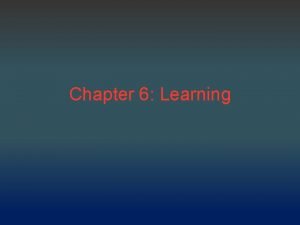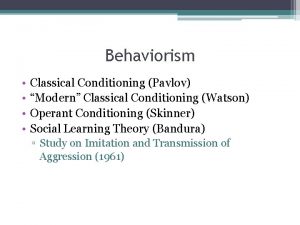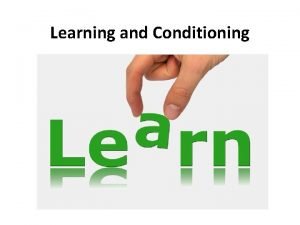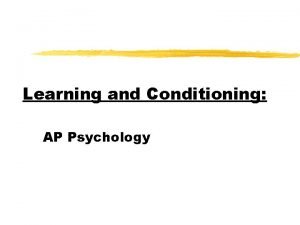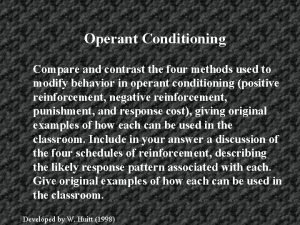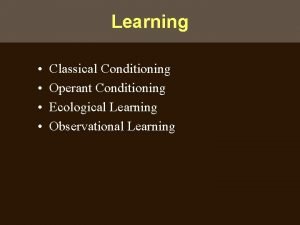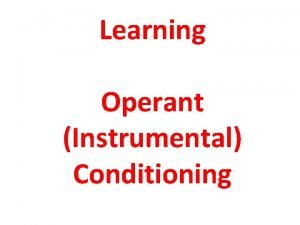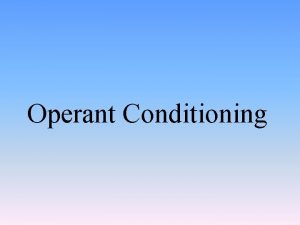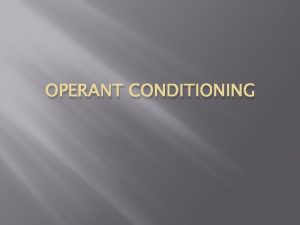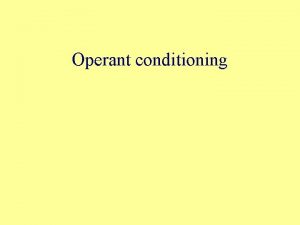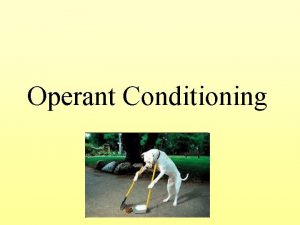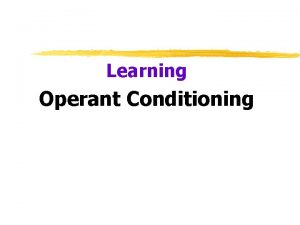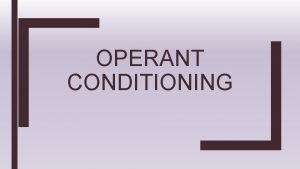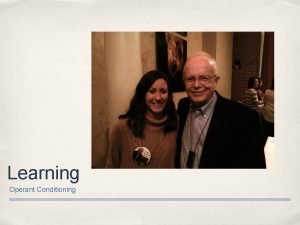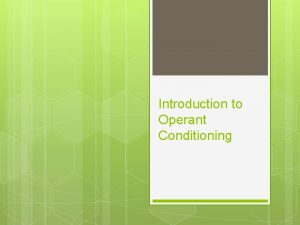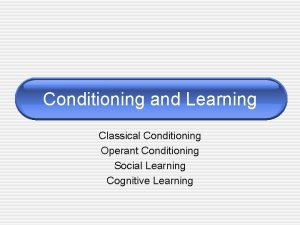Classical v Operant Conditioning R Peters PSYCH SY













- Slides: 13

Classical v. Operant Conditioning R. Peters PSYCH SY 2010 - 11

Classical Conditioning • Is based on stimulus-response relationships. – A stimulus is an object or a situation that excites one of our sense organs. • Often a stimulus makes a person respond in a certain way, as when a flash of light makes us blink. • Psychologists say that in this instance the stimulus elicits (draws forth) the response.

Components of Classical Conditioning • In classical conditioning, learning occurs when a new or conditioned begins to elicit behavior similar to the original unconditioned response that was originally produced by an unconditioned stimulus. – The unconditioned stimulus is one that unconditionally, naturally, and automatically triggers a response. – For example, when you smell one of your favorite foods, you may immediately feel very hungry. – In this example, the smell of the food is the unconditioned stimulus. – Classical conditioning has occurred because the new stimulus (the tone) has begun to elicit the response of salivation in much the same way as the lemon juice elicited it. – The unconditioned response is the unlearned response that occurs naturally in response to the unconditioned stimulus. In our example, the feeling of hunger in response to the smell of food is the unconditioned response. • Any condition that makes learning occur is said to reinforce the learning.

Components of Classical Conditioning • The Conditioned Stimulus is previously a neutral stimulus that, after becoming associated with the unconditioned stimulus, eventually comes to trigger a conditioned response. – In the earlier example, suppose that when you smelled your favorite food, you also heard the sound of a whistle. While the whistle is unrelated to the smell of the food, if the sound of the whistle was paired multiple times with the smell, the sound would eventually trigger the conditioned response. In this case, the sound of the whistle is the conditioned stimulus. • The Conditioned Response is the learned response to the previously neutral stimulus. – In the example, the conditioned response would be feeling hungry when you heard the sound of the whistle.

Classical Conditioning • The classical conditioning process is particularly important in understanding how we learn emotional behavior. – When we develop a new fear, for example, we learn to fear a stimulus that has been combined with some other frightening stimulus. – Studies of classical conditioning are based on experiments performed in the early 1900's by the Russian physiologist Ivan P. Pavlov. • He trained dogs to salivate to such signals as lights, tones, or buzzers by presenting these signals when he gave food to the dog • Pavlov called the learned response a conditioned response because it depended on the conditions of the stimulus. • To emphasize the fact that a stimulus produces a response in this kind of learning, classical conditioning is often called respondent learning.

Examples of Classical Conditioning • These techniques are also useful in the treatment of phobias or anxiety problems. • Teachers are able to apply classical conditioning in the class by creating a positive classroom environment to help students overcome anxiety or fear. – Pairing an anxiety-provoking situation, such as performing in front of a group, with pleasant surroundings helps the student learn new associations. – Instead of feeling anxious and tense in these situations, the child will learn to stay relaxed and calm.


Operant Conditioning • What Is Operant Conditioning? – Sometimes referred to as instrumental conditioning. – Is a method of learning that occurs through rewards and punishments for behavior. – Through operant conditioning, an association is made between a behavior and a consequence for that behavior. • Operant conditioning was coined by behaviorist B. F. Skinner. – Skinner believed that internal thoughts and motivations could not be used to explain behavior. Instead, he suggested, we should look only at the external, observable causes of human behavior. – In other words, Skinner's theory explained how we acquire the range of learned behaviors we exhibit each and every day.

Examples of Operant Conditioning • We can find examples of operant conditioning at work all around us. – Consider the case of children completing homework to earn a reward from a parent or teacher, or employees finishing projects to receive praise or promotions. • In these examples, the promise or possibility of rewards causes an increase in behavior, but operant conditioning can also be used to decrease a behavior. – The removal of an undesirable outcome or the use of punishment can be used to decrease or prevent undesirable behaviors. • For example, a child may be told they will lose recess privileges if they talk out of turn in class. This potential for punishment may lead to a decrease in disruptive behaviors.

Components of Operant Conditioning • Some key concepts in operant conditioning: – A reinforcer is any event that strengthens or increases the behavior it follows. There are two kinds of reinforcers: • Positive reinforcers are favorable events or outcomes that are presented after the behavior. In situations that reflect positive reinforcement, a response or behavior is strengthened by the addition of something, such as praise or a direct reward. • Negative reinforcers involve the removal of an unfavorable events or outcomes after the display of a behavior. In these situations, a response is strengthened by the removal of something considered unpleasant. – In both of these cases of reinforcement, the behavior increases.

Components of Operant Conditioning • Some key concepts in operant conditioning: – Punishment, on the other hand, is the presentation of an adverse event or outcome that causes a decrease in the behavior it follows. There are two kinds of punishment: • Positive punishment, sometimes referred to as punishment by application, involves the presentation of an unfavorable event or outcome in order to weaken the response it follows. • Negative punishment, also known as punishment by removal, occurs when an favorable event or outcome is removed after a behavior occurs. – In both of these cases of punishment, the behavior decreases.


Classical v. Operant Conditioning
 Operant vs classical conditioning
Operant vs classical conditioning Instrumental learning vs classical conditioning
Instrumental learning vs classical conditioning Difference between operant and classical conditioning
Difference between operant and classical conditioning Classical and operant conditioning differences
Classical and operant conditioning differences Classical conditioning vs operant conditioning
Classical conditioning vs operant conditioning Generalization psychology
Generalization psychology Operant vs classical
Operant vs classical Operant conditioning classical conditioning
Operant conditioning classical conditioning Classical and operant conditioning.
Classical and operant conditioning. Different types of reinforcement schedules
Different types of reinforcement schedules Ap psychology learning
Ap psychology learning Fixed interval schedule example
Fixed interval schedule example Example of classical conditioning
Example of classical conditioning Law of effect thorndike
Law of effect thorndike

